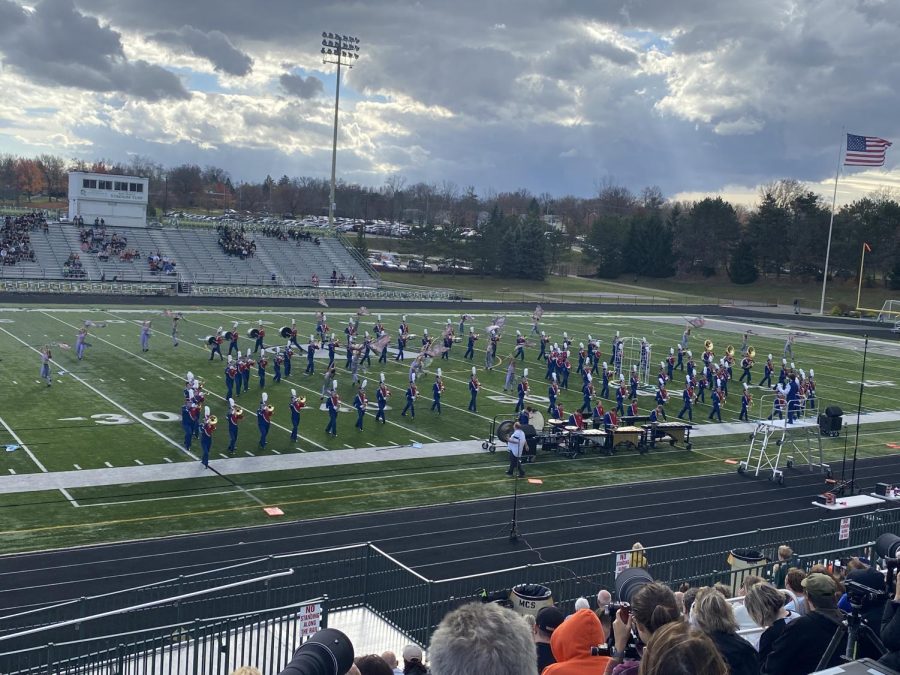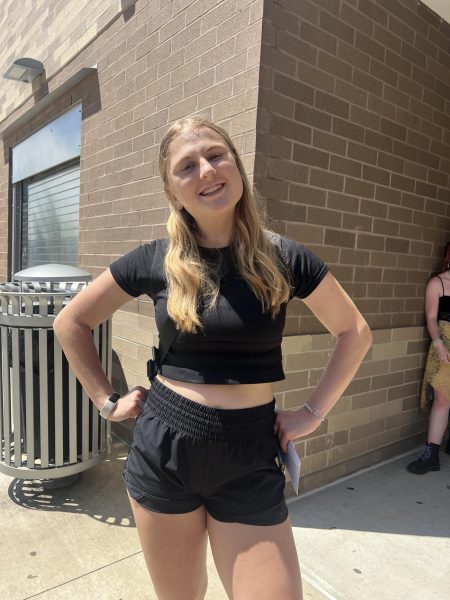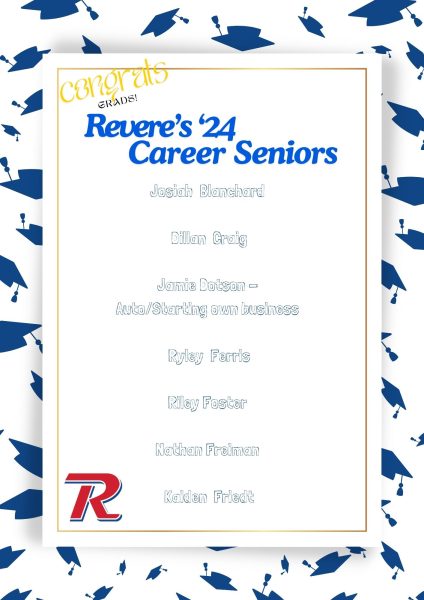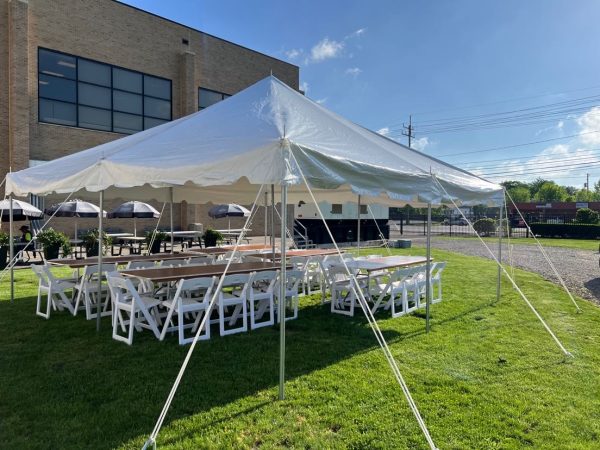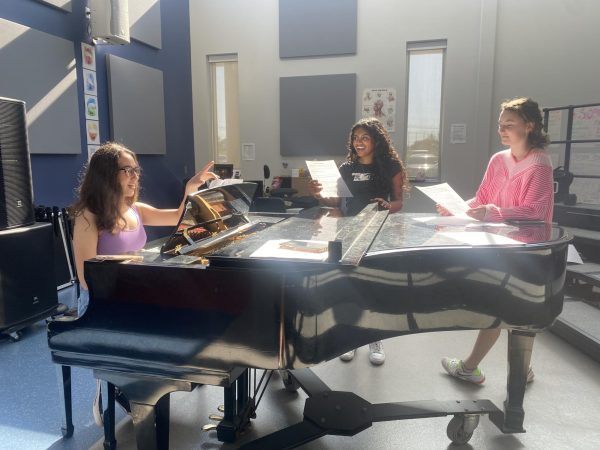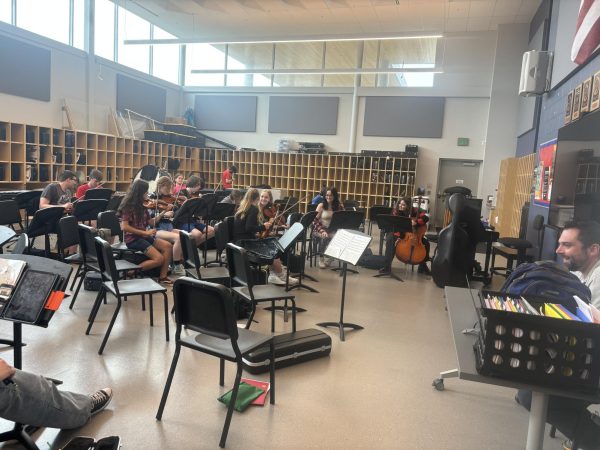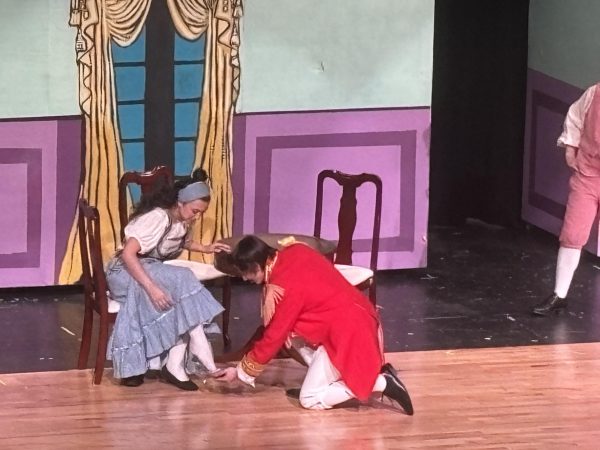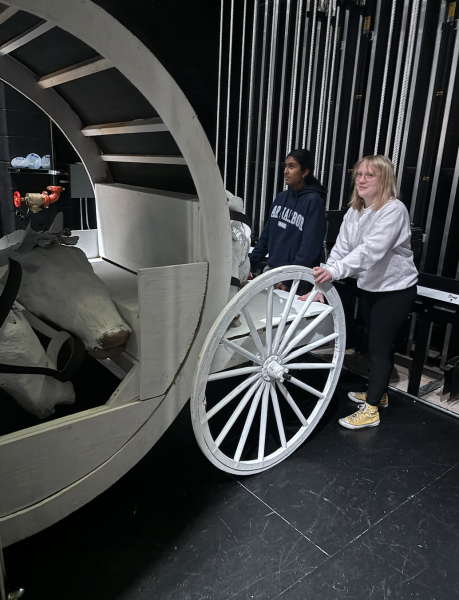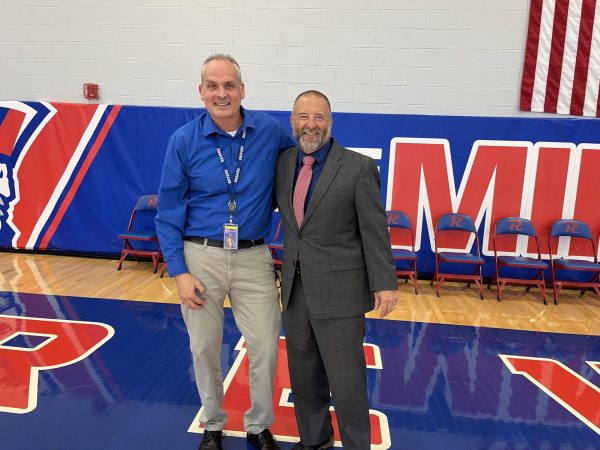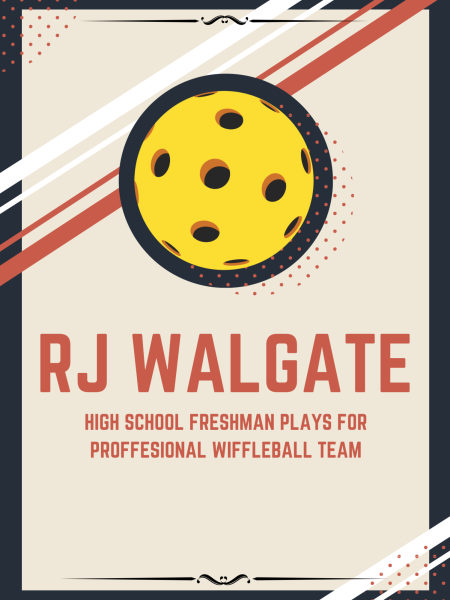Revere marching band continues to impress
The marching band performs at the state competition.
Marching band has evolved from a military institution to a main event during a football halftime show. The spectacle that has become a marching band is created through many different pieces of a much bigger machine, all moving together to produce beautifully choreographed music and visuals which they perform live at a bustling stadium. At Revere, the students and administrators in charge of the Marching Minutemen put an immense amount of effort into their show and spend time developing each component of the band.
Dr. Darren LeBeau and Jacob Taylor lead the band on the musical side, while Hali Piepsny and her two student instructors, Lilly Kayani and Kayla Kephart, take charge of the color guard portion.
While on the outside, it might seem like the only two seperate parts of the marching band are the color guard and the instruments, there are many smaller pieces to the puzzle that shape the annual state competition show the marching band performs.
The first step for LeBeau and Taylor before even beginning to plan the show is to find interested students. Balance in the band is very important, so they like to keep a certain rhythm throughout the sections both musically and in numbers of students in order to make the most beautiful sound possible later in the year. LeBeau will visit the middle school in January or February to talk to the students about marching band and its demands. One of these demands is one to two months of training in the summer, a process called band camp. Students are to report to the high school for six hours a day, every week day in order to learn all of the important steps to being in marching band.
“We cover a lot of territory in those six hours each day because we have a performance our very first week at a community parade and our first football week on the third Friday of band camp, so we gotta get [it] done,” LeBeau said.
As crucial as band camp is to the band students due to the musical aspect, it is also very important for the color guard, as they have their own basics that need learning.
The color guard also takes part in this recruitment by holding clinics to show students what color guard is and what it entails. These clinics are put on by Kayani and Kephart, the student color guard instructors, over the summer at various times.
“[We hold] a couple of practices without the coaches to try and help people. Usually we’ll go, and we’ll help people learn a routine,” Kephart stated.
Kayani also said that these clinics are helpful for people who have missed a few practices or need some extra help in different areas of the routine. This is also a way for the team to meet each other and get to know each other better before the season kicks into full gear.
Colorguard instructor at Revere, Hali Piepsny, has a lot of work cut out for her at the beginning of the year. Her first goal is for everyone to learn and master the basics in order to keep moving with the routine and smooth everything else out. Due to Piepsny’s dedication to her craft and her style of education, most students are able to pick up the moves fairly quickly. When teaching students the first steps, Piepsny takes a friendly and open approach to it.
“It is crucial to teach the color guard students how the flag spins and the basics first. That way we can communicate to each other when I see something incorrect or they know they are doing something incorrectly, and then we work together to fix the problem,” Piepsny said.
A lot of preparation is necessary when talking about the show, and many different people are involved in helping it run smoothly and quickly. Senior Cassie Keaton is the band president and as president, she has many duties she has to perform regularly, such as planning and leading band council meetings and making announcements. In addition, she does many other small things which affect the band in various ways.
“I put on the car wash and run it, we do fundraisers, we run a field day which is an event that we do during band camp. After every football game we have a bonfire so I have to plan the bonfires. LeBeau and Jacob are the main people, but if somebody else needs something, they generally come to me, and I’m just in charge of making announcements and stuff,” Keaton said.
She also does a lot when it comes to improving the experience of band for students. Since band camp is so important, she wanted to come up with some ideas to motivate students during those long nine hours each day.
“This year, I was in charge of being able to dress up with the student section. That’s something I added as president, and then also fun Fridays, which would just be bringing in like popsicles or ice cream,” Keaton said.
Keaton has been a long time member of the band, and when reflecting on her time, she said that her favorite part about being in the marching band was the competitions and watching their improvement as the season progressed.
Another aspect of the marching band that may not receive much recognition, is the behind the scenes administrators who spend hours choosing the music, coordinating choreography and actually teaching the students as well.
“During April, myself and Mr. Taylor start talking about music and the theme maybe, because we start seeing stronger sections [where] we want to highlight certain people or sections we want to highlight and then we start looking for music that we want that will match the personality and style of the band,” LeBeau said.
The process of choosing a piece for the show is not always terribly hard. This year, LeBeau stated that Taylor chose the piece Juno because he had been wanting to do it for a long time. The song’s original story depicted the journey of a mythological bird, but the director decided they would take their own twist on it by incorporating a poem by Maya Angelou titled I Know Why the Caged Bird Sings. To do this, they recorded sections of the poem to play over a loudspeaker during the show. Along with this, the band utilized a human sized birdcage and large wooden peacock feathers that were unraveled during the show to signify the freed bird.
Once they were set in what the show piece would be, the next step was to reach out to the colorguard and give them time to create their own choreography. When doing this, Piepsny says she likes to just listen to the music first and get a feel for what it will look like.
“With the help of my amazing color guard instructors Keely Ryan and Hannah Andrews, we are able to collaborate and comment on each other’s ideas while writing work. The first thing I do is listen to the music and spin along, keeping in mind how I can visually represent the music,” Piepsny said.
Piepsny is excited about the recent growth of students joining the color guard in the past few years. She is very passionate about what flagline is—a way to visually represent the stationary notes on the page in creative and graceful ways.
“Although the choreography is written by the staff, it is important to recognize the performance that the color guard students create to bring the staff’s vision to life. With the growth of the color guard number in recent years, it is amazing to see a field full of students working together to paint a picture of what the music means,” Piepsny said.
For students, color guard is a huge step to take, because it is nothing like anything they have done before. Spinning a flag and being blasted in the ear with trumpets at the same time is its own experience that can’t be compared to any other. When it comes to their first few practices, Kayani says that the biggest challenge they need to get over is not a physical skill, it is preparation of the mind.
“[The hardest part of color guard] is just the mental challenge of getting over the idea of throwing a flag in the air and picturing it after you get hit in the face because it happens to everyone. It’s getting over it, still being able to do it and not being afraid of the flag,” Kayani said.
Even though it is a lot of work, both captains love the social aspect of the colorguard. They are able to meet new people and bond with them over the span of four months. For freshmen, it gives them a network and some familiar faces immediately on the first day of school.
After the initial idea is set for the show, the directors are able to collaborate and make changes as they go. As the season progresses and the students start to master the completion of the show, LeBeau and Taylor will start adding things to it. This could include a new position on the field or a more complicated step, all things that the band will pick up and continue working on up until their state competition in November. Throughout all of these changes, LeBeau promises that no matter how hard, in the end everything will come together.
“It’s three months of doing the drills, we are going to get you there regardless. That’s where we don’t want the music so hard that they’re miserable or drill so hard, but we want to keep adding new things, so that’s why we try to keep it fresh,” LeBeau said.
LeBeau believes the new additions also make it more enjoyable for the students because it gives them something different to learn each day instead of repeating the same moves every day for four months.
LeBeau believes one beneficial aspect of band is the social aspect and all of the possibilities that come from being exposed to so many people.
“You have 130 friends instantly before school starts, so you are not walking into school the first day and saying; I don’t know anybody,” LeBeau said.
Leading up to this competition, the band had many opportunities to practice. These include football games, band competitions on the weekends and smaller events such as parades. After each band competition, the band was given a rating, which usually varied from a one to a two out of five, proving that the students’ commitment and hard work paid off. Once the season is over, the students switch to a concert band, where they perform a few different concerts over the course of the rest of the year. The freshmen who participated in the marching band season have to participate in the concert band as well. This requirement allows for the band to keep members for both semesters and pushes freshmen to be open to both types of musical performance. LeBeau considers it important that freshmen take a variety of different classes at the beginning of their high school career. He advises students not to overbook themselves but instead take freshman year slow and allow time for acclimation to the high school. For the colorguard, they enjoy a study hall for the rest of the semester.
This year, the Revere Marching Minutemen got a one, a superior rating, in the competition, along with awards in color guard (visual effects) and percussion. On the beautiful sunny day the band competed alongside many other highschool bands of different classes and sizes. The pieces could range from songs from popular culture and classic musicals such as Les Miserable or The Greatest Showman to pieces like Juno with a more professional tone. As the wind picked up the color guards in each band had a little trouble with flags causing them to drop or fumble with the pole, but each recovery was graceful and spoke great lengths to the endurance of the talented students. When it was time for the Marching Minutemen to take the field they lined up and took their spots around the brightly painted peacock feathers. Soloist Johnston (J) Minisch was positioned inside a bird cage for his saxophone solo at the beginning of the piece. As the music commenced the students put all of their hard work over the past few months and left nothing in the classroom.
The experience of marching band is one that most students treasure for years to come. Between hanging out with friends, learning new skills and getting a crazy tan due to all that time on the field, students learn a lot and grow during their time. LeBeau and all of the other directors are huge pieces to this puzzle, making their time together enjoyable but insightful.

